Skin cancer is the most common cancer in the U.S., and its the No. 1 cancer in men older than 50. Take a glance around the marina: One in five Americans will develop skin cancer in their lifetime, one in three Caucasians. More than 3.5 million new cases are diagnosed annually, and 90 percent of all skin cancers are associated with sun exposure.
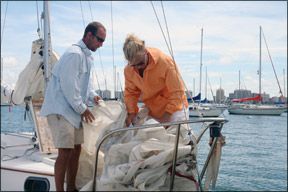
Those are sobering statistics from The American Melanoma Foundation and The Skin Cancer Foundation (SCF), and sailors should take heed. Being immersed in nature-the wind, water, and sun-is what makes sailing so energizing, but given the statistics, we can’t forget there are risks involved.
In past issues, weve delved into the risks of sun exposure and options for protection, including sunscreens (June 2007), sunglasses (July 2009), and hats (June 2008). For this report, we took a look at clothing designed to block the suns harmful ultraviolet (UV) rays. Fabrics create a physical barrier, a shield that is longer-lasting, more effective, and more reliable than sunscreens, which have to be re-applied frequently, can be washed or rubbed off, and often are packed with skin-irritating chemicals. No sunscreen can totally block the suns rays, but there are fabrics that can.
Although all clothes offer some protection from UV, not all fabrics have adequate protection. We know that loose-fitting clothes made from tightly-woven, dark, synthetic fabrics block more UV than a stretched-out white cotton T-shirt. But what we sought to determine with this test was whether a $50 shirt designed for sun protection is really a better choice than our stockpile of regatta T-shirts or a regular, dark-colored synthetic shirt that can be bought at a thrift store.
The Basics and Standards
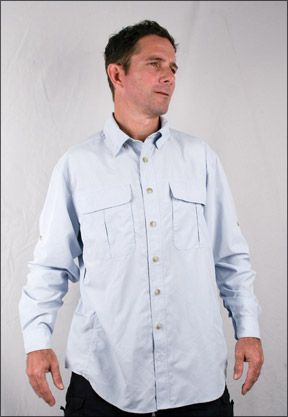
Just as sunscreens are identified with a specific SPF (Sun Protection Factor), UV-protective clothes carry a UPF (Ultraviolet Protection Factor) score. The SPF scale measures the amount of time it takes for sun-exposed skin to become red. UPF is the measure of how much UV radiation can penetrate the fabric. For example, a shirt with a UPF of 50 allows 1/50th (or 2 percent) of the UV radiation to reach the wearers skin. According to the Skin Cancer Foundation, a regular, fairly new white cotton T-shirt has a UPF of about 7 while a long-sleeved denim shirt is a complete blocker with a UPF of about 1700.
The UPF value can be affected by such fabric characteristics as tightness of the weave, the size and opacity of the yarns, optical brighteners used in dying, and fabric color. Some fabrics block UV rays simply because of their construction or material, but others must have a UV-absorbing finish applied in order to have an acceptable UPF rating.
Clothes marketed as sun protective typically carry a UPF of 50-plus; however, there are no government standards regarding these claims, there are only
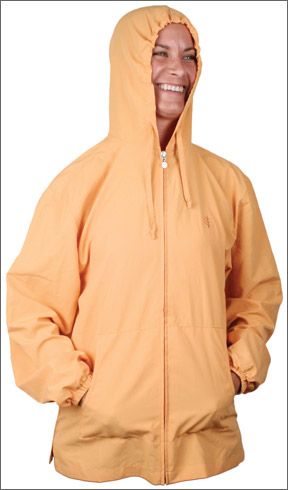
voluntary industry standards. According to testing standards set by the American Association of Textile Chemists and Colorists (AATCC) and the American Society for Testing and Materials (ASTM), a manufacturer can only claim a garment is UV-protective when its UPF score is 15 or better: 15 to 24 (good UV protection); 25 to 39 (very good protection); and 40 or higher (excellent protection).
Makers usually note a garments UPF on the clothings tag. But because compliance with the standards isn’t mandatory, you can’t always trust what you read on a label. The Good Housekeeping Research Institute (www.goodhousekeeping.com), using an independent lab, found that of the 15 garments it tested, two brands (Outdoor Research and Triple J) tested to slightly lower UPF scores than their makers claimed, and two others (Sunveil and Solarveil) showed 0 percent UV blockage although they claimed 90 percent blockage or better.
So how can you be certain that youre not getting ripped off and that what youre wearing offers optimum protection? Look for The Skin Cancer Foundation Seal of Recommendation. As we reported in the sunscreens test, the SCF has a certification program for products including sun-protective apparel, cosmetics, and sunscreens. To get the SCFs Seal of Recommendation, fabrics must have a UPF of 30 or greater and validation of the UPF through tests that comply with the AATCC (183) and ASTM (D6544) standards. The SCF considers a UPF rating of 30 to 49 to be very good protection and 50-plus excellent protection. The SCF lists all logo-carrying products on its website, www.skincancer.org/seal/.
The American Academy of Dermatology (www.aad.org) recently discontinued its recognition program, but its website has some good resources, including a locator map of doctors across the U.S. who offer free skin screenings.
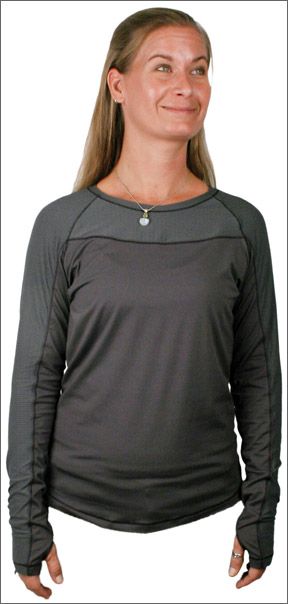
What We Tested
There are numerous companies out there that market sun-protective apparel. Some are niche retailers specializing in UV-blocking gear, and others are activewear makers that have included sun protection in their designs. For this evaluation, we chose to look at mens and womens products from both types of companies, but with the stipulation that the garments must carry the SCF Seal of Recognition. Only six companies make apparel that carries the SCF seal-including the Boy Scouts of America, surprisingly.
From sun-protection apparel maker Coolibar, we tested a unisex jacket and a mens button-down shirt. Columbia Sportswear Co., which manufactures outdoor apparel for a range of activities, sent us a selection of UV-protective clothes: a womens shirt, a womens hoodie, a pair of womens pants, and two mens shirts. The Coolibar gear has a resort-wear look to it, while the Columbia clothing better fits the activewear category.
All but one of the Coolibar and Columbia test garments have a UPF or 50 or better. Many of the styles come in both mens and womens designs, and both companies also manufacture UV-protective gear for kids. Both Coolibar and Columbia told Practical Sailor that their UPF fabrics comply with industry standards for UPF testing.
How We Tested

Testers conducted tests similar to those outlined in industry standards AATCC 183 and ASTM D6544. These call for fabric to be tested using a spectrophotometer, which measures how much UV light passes through the fabric and calculates the percentage of UV blocked to determine the UPF rating. The standards also specify that the UPF score listed on a label should reflect the maximum UV that can pass through the fabric after two years of regular wear. To that end, the standards require that the fabric be exposed to laundering (40-plus washings), simulated sunlight (roughly 100 hours of UVA-UVB rays), and chlorinated water-simulating two years of use-before being UV tested.
Practical Sailor
To gauge the test clothes quick-dry ability, testers soaked them in salt water and timed how long it took each to dry. For odor and mildew resistance testing, the shirts were wetted with seawater, sealed in a plastic bag and placed in the sun for four days. The ratings in both the quick-dry and odor-resistance tests were relative to the field.
The garments were further evaluated on construction quality, fit, comfort, and color fastness and dimensional stability after 10 washings. Price, availability, and versatility also were noted.
Coolibar
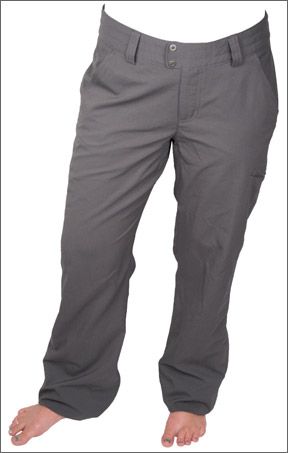
The first company to receive the SCF seal for sun-protective clothing, Coolibar markets more than 300 sun-protective products for all ages and offers a 100-percent satisfaction guarantee. The apparel we tested is made of Dri Suntect fabric, which has millions of small titanium-dioxide particles permanently embedded into each fiber, giving the fabric a UPF of 50. The tightly knit fabric uses ultrathin polyester microfibers to wick away moisture, and the titanium dioxide diffuses UV rays.
We tested the unisex Sun Block Jacket and the mens Travel Shirt. Testers noted that the wrinkle-resistant, moisture-wicking Suntect fabric was extremely soft and felt good on the skin, seemingly cooling testers down when they wore it, even after extended wear in the full summer sun.
While the jacket is marketed as unisex, the color palette is decidedly pastel, and the extra-small was a bit loose on one petite, size 4 woman tester-but in the summer heat, looser was better.
Testers like the jackets features, including the front pockets, mesh side vents for good air flow, and stow-away hood for protection above the shoulders. Its weak point was the low-grade metal zipper, which likely would corrode after some use on a boat. Testers also noted that the mesh side vents allowed a bit more UV through than the nylon jacket body: 2.5 percent versus 0 percent.
The button-down Travel Shirt had the same super-soft feel of the jacket. This versatile shirt could easily be worn for a day of sailing or an evening at the yacht club. It also offers several features that testers havent seen on any other shirts of the same style: hidden buttons for the button-down collar and a three-layer collar design. The shirt also has hidden mesh vents at the side seam and across the back; Velcro flap pockets and a hidden security pocket; and roll-up sleeves with button tabs.
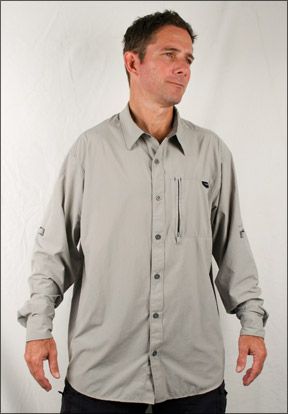
Bottom line: The Coolibar products performed well and have innovative features. At presstime, all Coolibar summer products were 30-percent off, making them a good buy for those seeking comfortable, quality casual wear with UV protection.
Columbia Sportswear
Activewear-maker Columbia uses a patented design and manufacturing process to create its Omni-Shade fabrics. All of the Columbia products we tested were made of quick-dry, moisture-wicking Omni-Shade fabric, which combines tight-weave construction, UV reflectors, and UV-absorbers that results in UPFs of 30 to 50. All were comfortable, breathable, and fit true to size.
The womens Anytime shirt and half-zip hoodie are slim-fitting and soft, making them good candidates for layering or wearing alone. The polyester-nylon-elastane fabric is comfortable and stretchy-excellent for high-activity days racing around the buoys. Both have thumb holes, keeping the sleeves in place and extending protection to the hands. The shirts sides and shoulders (and hood on the hoodie) are of a thinner, textured fabric that actually let in 2.9 percent more UV than the shirt body in our tests. We thought it curious that the shoulders would have less protection; however, the fabric still meets industry UPF standards.
Testers found the womens Silver Ridge Stretch polyester pants to be lightweight, airy (thanks to multiple vents), and have sufficient pockets. The pant legs zip at the bottom to accommodate boots and also have a cinch cord that will help keep them from being snagged.
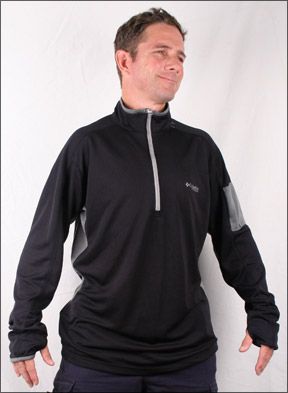
The mens High Line Ridge Shield button-front shirt was just as comfortable as the Coolibar mens shirt, testers reported, and offered loads of ventilation and pockets. Its nylon-elastane fabric offers excellent stretch for mobility and also had a tendency to shed light spray. Like the Coolibar, this shirt has a zip security pocket and roll-up sleeves with button tabs.
The mens Optimus half-zip seems better suited as a base layer than a stand-alone shirt as it offers only UPF 30, compared to the others UPF 50. The only notable feature is the tops media pocket on the left arm, which can accommodate an iPod or other lightweight device but isn’t beefy enough to store car keys or a handheld GPS. Testers also noted that the black shirt would be too warm to wear in tropical climates.
Bottom line: Columbias Omni-Shade apparel is well-made and offers adequate protection. The gear is a great fit for active sailors who prefer high-stretch clothes that can be worn monkeying around a foredeck or while traversing the trail.
Conclusion
Protecting ourselves from health risks and sun damage is a no brainer, but when it comes to spending $50 for a shirt, we need some convincing. The skeptic in us wanted some proof that a specially designed UV-protective garment wasnt just marketing hype. As the test showed, regular clothes can offer adequate UV protection, but there are other things to consider: Cotton stretches; its colors fade; and when it gets wet, its protective quality is cut in half. The protection is not consistent or reliable.
The bottom line is that if all youre seeking is sun protection, a $3 long-sleeve, tightly woven, dark-colored polyester shirt from the thrift store will suffice; just be sure to replace it once it starts to stretch or wear. If youre looking for optimum UV protection in quality activewear-loads of ventilation, quick-dry capability, hidden pockets, full coverage via a tri-fold collar or sleeves with thumb holes, and other extras-then both the Coolibar and Columbia gear fit the bill. All of the test products were excellent in terms of quality of construction, and both makers offer a wide range of gear that will appeal to different tastes. If you plan to wear them in hot climates, we recommend going for the looser garments.
Rules of Thumb
For those not inclined to invest in high-tech UV apparel, remember the basic rules that apply to choosing fabrics that optimize protection: If you can see through it, so can the sun. Darker colors offer better protection. Synthetics (nylon or polyester) can be woven very tightly, deflecting more UV than cotton or linen. For natural fibers, check out laundry aids like RITs Sun Guard, which carries the SCF seal and claims to add UPF 30 protection to clothes. Were testing the product and will report on it in a future article.
testers used a Solartech Solarmeter digital UVA-UVB radiometer to determine the amount of UV each test garment blocked. Testers took readings when the products were brand-new and then again after the clothes went through 10 wash-and-dry cycles. (See test results in the Value Guide.) We compared those results to the UV readings we took on three regular shirts: a white T-shirt, a dark red T-shirt, and quick-dry, breathable running shirt.





































